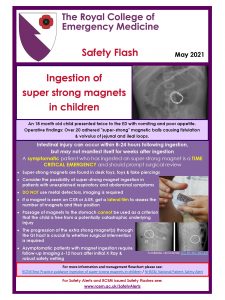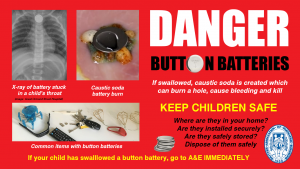Template File: /www/wp-content/themes/stn2017/single.php | Template Hierarchy
WP version: 6.6.2
PHP version 8.2.24
This week is Child Safety Week hosted annually by the Child Accident Prevention Trust (CAPT) to raise awareness of preventable serious injury and death.
In our Paediatric working groups digestion of Button Batteries and Magnets are frequent topics with some parents unaware of the potential dangers. In the United Kingdom, clinicians have seen an increase of nearly double patients attending the Emergency Department with this injury.
Whys is swallowing button batteries and magnets so harmful?
Button Batteries
Surprisingly, the harm is not usually caused by the chemicals leaking from the battery but due to the battery itself reacting with bodily fluids, such as mucus or salvia. This creates a circuit to release a substance like caustic soda, which is a strong alkali that can burn through tissue. Alkaline substances are on the opposite end of the pH scale to an acid but is still very dangerous. ‘Dead’ or ‘Flat’ batteries also have the potential to release the alkali so should be treated with the same caution.
BBC have released a video to highlight the risk of button batteries if they are digested:
Magnets
If magnets are digested, they effectively burn holes in the intestines or bowels. The magnets stick together internally and through organs and tissues, and can cut off blood supply causing the tissue to die. Magnets are much more complex than button batteries to extract. The patient would need emergency surgery, then, depending on the severity of injuries, they may need numerous operations, bowel resection and time in intensive care.
The below picture from CAPT shows an x-ray from the case of a three-year-old swallowing small, round coloured magnets from a magnetic toy.
How to keep your children safe!
The British Association of Paediatric Surgeons have produced a set of questions to consider:
what are the symptoms after swallowing?
Button Batteries:
Magnets:
IF YOU EXPECT YOUR CHILD HAS SWALLOWED A BUTTON BATTERY OR MAGNET, GO TO YOUR CLOSEST EMERGENCY DEPARTMENT AS SOON AS POSSIBLE.
Many trusts, organisations have campaigned for the trading standards for magnets and button batteries to be changed, recently the standards had changed for button batteries.
Helpful Resources:
The Royal College of Emergency Medicine: website

British Association of Paediatric Surgeons: website

Child Accident Prevention Trust – website
Healthcare Safety Investigation Branch – Final report – Healthcare Safety Investigation Branch (hsib.org.uk)
Building Safer Communities – Building Safer Communities (harmandinjuryhub.scot)